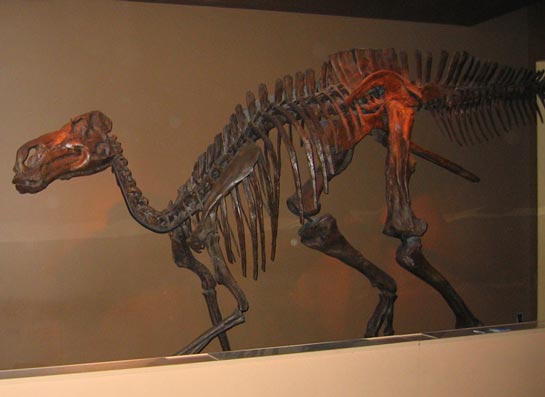Hadrosaur Skeleton Badly Damaged in Attack by Vandals
Over the last six months or so officials in Canada have reported a number of deliberate acts of vandalism carried out against dinosaur fossils being excavated in the province of Alberta. In this latest attack, the fossilised remains of a Late Cretaceous herbivorous dinosaur were smashed by a person or persons unknown. Vandals have damaged a duck-billed dinosaur skeleton.
Duck-billed Dinosaur Skeleton
The remains of large dinosaurs often take months to extract out of the ground, indeed as great care is needed to protect the fossilised remains and preserve scientific data, some excavations can take years. This means that many sites once identified may be left after only a partial excavation. Field workers would deliberately bury bones, having taken precautions to preserve them so that the site can be re-visited at a later date and a more thorough investigation carried out.
This is exactly what happened when Dr Philip Bell and his colleagues of the Pipestone Creek Dinosaur Initiative came across the partially exposed remains of an eight-metre-long hadrosaur. The site was mapped on June 15th and there were several days of excavation, then Dr Bell and his team had to return to their other projects so the scientists carefully covered the site so that they could return a few weeks later and continue their work. To Dr Bell’s dismay, when he returned to the site, near Grande Prairie (north-western Alberta), he discovered that much of the site had been attacked by vandals and many of the fossil bones smashed.
A Typical Hadrosaur Skeleton in a Canadian Museum
Picture credit: Everything Dinosaur
The palaeontologists are concerned that the hadrosaur specimen may have been irreparably damaged. This is just one of a number of acts of vandalism against dinosaurs that have been reported in the Canadian press this year.
Commenting on the demise of his duck-billed dinosaur, Dr Bell stated:
“This was destined to become a major exhibit in the new museum [new dinosaur museum, located north of the Canadian town of Wembley]. Of course, now it’s really compromised. It’s not really a skeleton any more. It’s more of a jumble of bones… Maybe there’s a few things that are still complete in there, but as far as the exhibit was concerned, that’s no longer feasible.”
Dinosaur fossils are exceptionally rare. Each new discovery helps palaeontologists to learn more about these prehistoric creatures, Dr Bell went on to add:
“Each bone is irreplaceable. We still know very little about the dinosaurs that existed up here [northern Alberta], so every skeleton is crucial.”
Most of the bones were still in situ, so the site had not been raided by souvenir hunters or illegal collectors keen to sell specimens outside of the law. The fossil remains seem to have been broken deliberately in a wanton act of violence.
Although dinosaur fossils can fetch high prices if sold at auction, it is illegal to poach or even damage any fossil material in Canada. Such transgressions can be punished by hefty fines of up to $40,000 CDN or even twelve months imprisonment.
Despite the best efforts of the authorities, the incident of the damaged hadrosaur is not the only recent fossil crime that has been reported from Canada. A number of such attacks have been recorded this year. In Pipestone Creek Park (Alberta), near to where the hadrosaur remains had been located, a substantial bone bed containing the fossilised remains of a number of dinosaurs was damaged in May. There have also been a number of dinosaur fossil thefts reported from dig sites and museums over the last few months or so.
The Royal Canadian Mounted Police in an official statement said that they were investigating the incidents, but as yet do not have any suspects.
Let us hope that the individuals are soon caught and this indiscriminate damage to Canada’s fossil heritage is soon stopped.
For models and figure of duck-billed dinosaurs and other ornithischian dinosaurs: Museum Quality Figures of Ornithischian Dinosaurs (PNSO Dinosaurs).







Leave A Comment